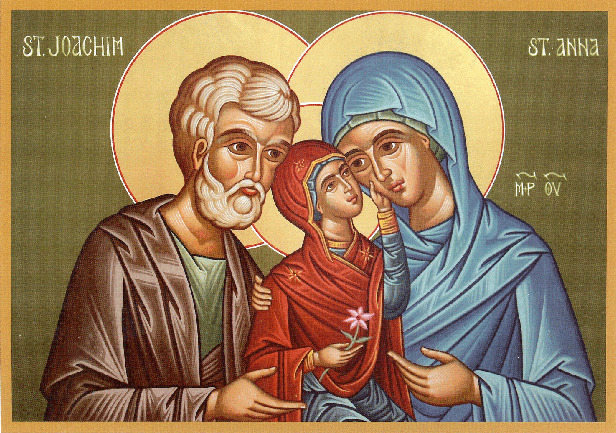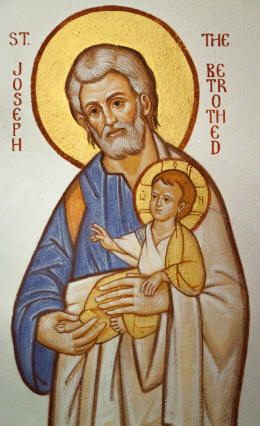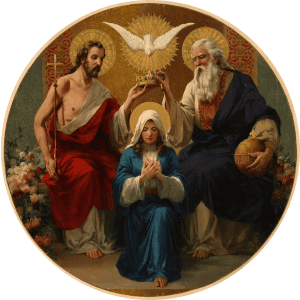| Orthodox Outlet for Dogmatic Enquiries | Papism |
|---|
The teaching on the Theotokos'...."Immaculate Conception"

By
Protopresbyter Fr. Theodore Zisis
|
1. The Papist heresy and the Orthodox position.
Also included among the contemporary, heretical dogmas of Papism is
their teaching on the “immaculate conception” (immaculata conceptio) of
the Theotokos. According to this teaching, the Theotokos was exempt, not
only of personal sins, but also of the Original Sin itself, which is
transmitted to all of mankind, through biological birth; that is, she
was supposedly conceived by her parents Joachim and Anna “immaculately,”
without the Original Sin being transmitted to her.
This heretical teaching had been rejected for entire centuries, even by
prominent Papist theologians such as Thomas Aquinas, because in addition
to having no basis in the Bible and Patristic Tradition,
it derogates the uniqueness of the supernatural birth of our Lord Jesus
Christ. Only Christ was born immaculately, having interrupted with His
natural (carnal) Birth the
successive
transmission of the Original Sin, given that His conception was not the
natural kind, but supernatural;
He was not conceived by the will and the union of man and woman, but
without seed - “by the Holy Spirit and the Holy Virgin Mary.”
The Most Holy Theotokos had no experience of man («áðåßñáíäñïò»)
and no experience of marriage,
(«áðåéñüãáìïò»)
and furthermore was “man-less”
(«Üíáíäñïò»)
– that is, she had no husband, no man.
The
elderly widower
Joseph
(Her Betrothed) was only Her guardian and chaperone, which is
why, on learning that She was pregnant, but not having yet learnt of the
wondrous conception by the Holy Spirit, he had thought of sending her
away:
“18 Now
the birth of Jesus Christ was thus:
“... after His mother Mary was betrothed to Joseph, before they
ever came together, she was found with child by the Holy Spirit. 19 As
for Joseph, her husband, being just and not wanting to make her a public
example, he wanted to send her away secretly”
(Matth.1:18-19).
Although a virgin, the Theotokos gave birth in a miraculous manner,
while She Herself remained a virgin even after childbirth. She is thrice
a virgin and ever a virgin: pre-natal, during childbirth, and
post-natal.
Icon of The Theotokos, "The root (family tree) of Jesse" The same did NOT occur with the conception and the birth of the Most Holy Theotokos. She was of course conceived thanks to a miracle - by Her barren and aged parents, Joachim and Anna - but in every other aspect was born according to natural laws: There was a union between husband and wife, marriage and insemination. Anna, the mother of the Most Holy Theotokos, had NOT been without experience of man («áðåßñáíäñïò») or without experience of marriage («áðåéñüãáìïò»). She was NOT husband-less (Üíáíäñïò), nor was she a virgin; she had Joachim as her husband. The conception of the Most Holy Theotokos was ÍÏÔ “seed-less”, but by the sperm of Her biological father Joachim, the way it is with all of mankind.
THAT is the reason
the Original Sin was transmitted to Her as well.
The only immaculate and supernatural conception was that of the God-man
Christ, by the Virgin Mary and the Holy Spirit - and without
insemination. Christ is the only sinless One in every way – the
perfectly and absolutely sinless One. The Most Holy Theotokos is
relatively sinless, being one
who has partaken of the Original Sin.
And yet, albeit presented with such a clear ecclesiastic teaching, and
despite it being supported by many Papist theologians, Pope
É×
did not back away,
but instead, he innovated arbitrarily and selfishly, by elevating the
teaching of “immaculate conception” to the status of a dogma in 1854,
thus adding another heresy to the many other heresies of Papism.
It has been supported by many researchers that this act was the
preparation of another terrible heresy and delusion of Papism: the
pope’s “infallibility”, which was dogmatized soon after by the 1870
Vatican I Council. With this
move, the Vatican wanted to establish that the Pope is not bound by the
Holy Bible or Patristic Tradition; he can even dogmatize against both,
because he is “infallible.”
2.
Ôhe
Hymn for the Dormition
of the Holy Mother
does not teach “immaculate conception.”
We have plainly and concisely presented the relevant teachings: the
heretical Papist one, and the Church’s orthodox one, where one can find
many more details in the dogmatic manuals by Orthodox theologians and in
special monographs. Our concise and pastoral preoccupation with this
matter was incited by a commentary in the newspaper “ORTHODOXOS TYPOS”,
Issue No.1819 of 12/2/2010, in the column
“EVENTS AND COMMENTS” and
titled: “Immaculate” conception and “seed-less” conception”.
The reason for this commentary was a question submitted by a reader,
that, had we perhaps wrongly rejected the Papist dogma on the
“immaculate conception” of the Theotokos, given that in the 3rd Kathisma
hymn of Matins for the feast-day of the Theotokos’ Dormition mention is
made of Birth by seed-less conception?
If one does not carefully observe the text of the Troparion, they might
indeed become perplexed and wonder about its meaning.
The same question had been posed
to the author during almost the same period, and possibly by the same
person who had apparently wanted to cross-check and secure the reply so
that there would be no doubts and reservations.
At any rate, we hasten to say
that, if this Troparion was in fact teaching the “immaculate conception”
theory, the Papist theologians would have detected it by now, and added
it to their “weaponry” against those who reject their heretical dogma -
especially against us Orthodox Christians – and accusing us of not
paying attention even to our own texts of worship. They have done this
before (especially with the renowned Papist theologian M. Jugie), when
invoking Holy Fathers, whose quotes they however abuse and misinterpret.
Still, to the best of our
knowledge, they have not invoked this particular Troparion – an omission
which in itself signifies that it does not support the “immaculate
conception” dogma. If it did support that dogma, it is almost certain
that they would have made use of it by now.
Nonetheless, let’s see what the Dormition Troparion says, and what its
theological meaning is:
Kathisma. Tone 3.
In your Birth, a seed-less conception;
In your Dormition, an incorruptible death;
A wonder within a dual wonder coincided, o Theotokos.
For how does She, who has no experience of a man, suckle an infant and
yet remain chaste?
And how can the Mother of God also be a fragrant death-bearer?
That is why, together with the Angel, we cry out to You: “Hail,o You who
are full of grace!” The problem arises from within the first phrase: “In your Birth, a seed-less conception,” and especially the Genitive case of the word “your”, which, according to the Greek syntax, is not subjective but objective, and as such, should not be interpreted as “when you were born”, but “when you gave Birth”.
Therefore, in this text, it implies
“In your (child)Birth” -
when you gave birth to your Son, the Christ, and not “when you were
born” by Joachim and Anna. This unquestionable interpretation is
reinforced by the pursuant, determinant phrase, “a seed-less
conception”, which clearly refers to the birth, NOT of the Theotokos by
Joachim and Anna, which involved insemination, but to the Birth of
Christ by the Theotokos, which was
by the Holy Spirit:
No one so far (not even Papists), has dared to claim that the Birth of
the Virgin Mary by her parents was “seed-less”.
Consequently,
the hymnal words addressed to the Theotokos:
“In
your Birth, a seed-less conception”
are interpreted as follows:
“At the Birth of your Son, Whose conception was seed-less”,
and NOT:
“At the time of your birth, whose conception was seed-less.” The Apolytikion (Closing Hymn) of the Sunday of the Holy Forefathers (the second Sunday before Christmas), says clearly that the Virgin Mary was born “out of the sperm” of her parents, whereas She herself gave birth to Christ without seed.
“The
saints boast in glory, for from their seed there is a glorious fruit:
She, who bore You without seed.” In the also familiar glorification hymn of Vespers, the “Theotokion” of Tone 1, it is mentioned that the Theotokos was sown by humans:
"The
worldwide glory, who was sown by humans and who gave birth to the Lord.” The pursuant phrase of the Kathisma of the Dormition likewise refers to the Birth of Christ and not of the Theotokos. After speaking of the dual wonder (the seed-less conception of Her Son, and the incorruptible necrosis of Her body), a clarifying phrase follows, beginning with the word “for”: "For how does She, who has no experience of a man, suckle an infant and yet remain chaste? "
How is it possible that You, who have never become familiar with a man,
have remained a chaste virgin, and yet are nurturing a baby with Your
milk?
There is subsequently no doubt that the said Kathisma hymn has nothing
to do with the Papist dogma of “immaculate conception.”
It clearly refers to the only
immaculate and seed-less conception of our Lord Jesus Christ, Who was
born of the Theotokos and the Holy Spirit supernaturally, thus
inaugurating the spiritual birth by the Holy Spirit of all the faithful,
within the Font of Holy Baptism.
Translation: R.I
The Room of the Immaculate Conception was commissioned by Pope Pius IX following the Promulgation of the dogma of the "Immaculate Conception" - 1854
Painter Francesco Podesti 1800-1895 fresco papal apartments
Vatican, Rome, Italy
|




